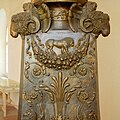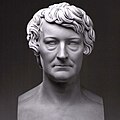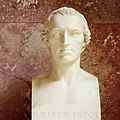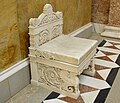Ernst Mayer (sculptor)
Ernst Mayer (born June 24, 1796 in Ludwigsburg , † January 21, 1844 in Munich ) was a German classicist sculptor . He was one of Antonio Isopi's students and Leo von Klenze's employees . He worked mainly in Munich, where he taught and worked as a professor at the polytechnic school from 1830 .
Life
Origin and career

Mayer was the ninth child of the hosiery manufacturer Johann Ernst Mayer (1754–1812) from Göppingen and his wife Christina Dorothea geb. Buck (1752-1813). From 1802 to 1810 he attended elementary school (pagerie) in Ludwigsburg Palace , where his father Johann Ernst Mayer had been the court and garden overseer for the Duke and later King Friedrich I of Württemberg from the 1790s . He gave his son Ernst in 1810, when the "Instituto delle belle arti di Ludwigsburg" was opened, to be taught by the sculptor Professor Antonio Cavaliere Isopi . With him, Ernst Mayer learned not only the “craft” of the sculptor, metal caster and ornamentist but also Italian, which he benefited from during his later stay in Rome.
Ernst Mayer completed his training on April 10, 1813 and then worked for Isopi at the art school in Ludwigsburg until 1819 and as a model maker in the ironworks in Wasseralfingen , where Isopis' colossal lion and deer were made from cast iron - they are still ahead of the new Castle can be seen in Stuttgart.
Restorer and creator of his own works in Munich and Rome
In 1818 Leo von Klenze brought the twenty-two year old Ernst Mayer to Munich with his teacher Isopi and employed him in his workshop. At the same time registered in the register book of the Academy of Fine Arts in Munich (No. 00487). Between 1818 and 1820, Mayer restored antiques for the Glyptothek , initially with and later without his teacher Isopi . In addition, he also made stucco models for the ceiling in Klenze's riding hall and molds for Johann Martin von Wagner's models of portal and facade decoration. Wagner models to Klenzes Centauromachy -Skizze (battle with the Lapiths) for round arch gusset of the portal of the new riding school ( Marstall Munich , former Riding School ) were executed in marble: the left of Johann Nepomuk Haller and the right of Giuseppe Lazzarini.
From 1821 to 1825 Mayer stayed in Rome, where he again worked for Johann Martin von Wagner, the Crown Prince's antiques purchasing agent, King Ludwig I from 1825 , and was also employed in Bertel Thorvaldsen's atelier . Here, Mayer made the first two large marble reliefs of the 85 m long frieze in the Valhalla at the portal entrance according to a design by Johann Martin von Wagner : first the "Aurora" and then the "Beginning of the Germanic peoples' departure from the Caucasus". Also for the Walhalla he created the bust of the Elector of Mainz and Arch Chancellor Berthold von Henneberg on behalf of Ludwig in Rome in 1824 . Mayer also worked on the tomb of Napoleon's stepson Eugène de Beauharnais (Duke of Leuchtenberg), who died in 1824 , which was created by Thorvaldsen according to Klenze's designs and Thorvaldsen's own model. The two geniuses on the base are from Mayer.
During a visit to Rome by the 14-year-old Bavarian Crown Prince Max, who later became King Max II , Mayer acted as Cicerone (tourist guide) and received a valuable porcelain service as a thank you gift when he was personally invited by King Ludwig to Nymphenburg Palace in the spring of 1826.
After his return to Munich, Ernst Mayer worked again from 1826 to 1830 in the Glyptothek, where he was also busy restoring antiquities. He then created a total of nine gable field figures for the outer facade of the Glyptothek, including three ancient artists who represent the three types of sculpture that Mayer himself practiced, namely the modeler (Koroplastes, in the illustration on the left), the ore caster ( Statuarius , in the picture on the right) and the stone sculptor with a self-portrait head who was lost in an air raid in World War II .
It is characteristic of the conditions in the art business at that time that a number of works that Ernst Mayer created were ascribed to other artists. It is often only possible to deduce from contemporary documents what part Mayer had in the numerous works of art created in the "team" - in the sequence of draft sketches and only then his work drawing, his own model and finally his processing of what he himself acquired and brought in Steins to the "original". For example, Leo von Klenze's draft sketches for many of Ernst Mayer's wood sculptures on numerous pieces of furniture in the royal rooms of the Munich residence are very similar to designs by the Napoleonic star designer Charles Percier , who Klenze was a student in Paris, and his friend and Colleague Pierre-François-Léonard Fontaine .
Professor in Munich

In 1830 Mayer was appointed professor for " Bossierkunst " at the polytechnic school in Munich. Now he was able to marry his long-time fiancée Amalie Burgett (1804–1880), a granddaughter of the Stuttgart Minister Carl Friedrich August von der Kettenburg (1735–1809), and start a family. The marriage resulted in a son and three daughters.
In the years leading up to his untimely death, Mayer was active in various fields of sculpture, including furniture making. In 1831 Mayer was given a medal of recognition from Duke Max Joseph in Bavaria for the "production of figures in the café-salon" from his Munich palace under the false first name Eduard .
Polymechanos Ernst Mayer was not only involved with the sculpture, but also with the logistics of marble quarrying and the transport of raw marble as well as finished works of art with horse-drawn vehicles across the Alps. He also invented a special art mill mechanism for the Untere Mühle an der Singold, acquired in 1837, first mentioned in 1279, and then the rye mill in Bobingen .
For the two mills in Bobingen, his widow Amalia Mayer was recognized by the community as the mill owner in 1844 to provide for widows. Another mill in Algertshausen , which is now part of Aichach, was acquired, the share art mill on the Paar that still exists today . This was later operated by the son Ernst Friedrich Mayer (1835–1906), who as a landowner, miller and grain trader was bread flour supplier to the Royal Bavarian Army , mainly to Munich, Ingolstadt and Augsburg .
tomb
Ernst Mayer died at the age of 47 on January 21, 1844 in Munich of the consequences of a fractured skull that he had suffered a few days earlier when he fell on black ice in front of his studio. The tomb of Ernst Mayer is on the old southern cemetery in Munich (burial ground 5 - row 15 - Place 56/57) Location .
student
One of his students was Arnold Hermann Lossow (1805–1874), who went to Ludwig von Schwanthaler in 1834 after a stay in Rome (1827–1833) . Mayer's successor at the polytechnic school was his student Johann von Halbig in 1846 .
progeny
Ernst Mayer's grandson was the legal historian Ernst Mayer , who taught at the Julius Maximilians University of Würzburg .
Works (selection)
- Stucco marble candelabra in Ludwigsburg Castle, final thesis in 1812, before the end of the apprenticeship in 1813, with Isopi inscription
- Artistic iron casting of the Württemberg heraldic animals, lion and deer, in front of the New Palace in Stuttgart in the Wasseralfingen ironworks; 958 working days with the production of lost molds and cores employed
- Marble bust of the queen widow Charlotte Mathilde von Württemberg, in Ludwigsburg 1821
- Two angels at the base of the Leuchtenberg tomb in St. Michael's Church in Munich (around 1829) - previously the 'trophies' helmet and armor at the Duke's feet, still in Thorvaldsen's studio in Rome, 1825
- Bust of Dürer on the 300th anniversary of his death in 1828, on the 'Stammbuch' in the castle, 1st prize in the tender of the city of Nuremberg
- Three large and six small figures in the gable of the Munich Glyptothek (1830–1833)
- Ten 2.33 m tall painter statues made of Abbacher sandstone for the war and post-war destroyed southern balustrade of the Alte Pinakothek [remains of the statues of Dürer and Jan van Eyck by Ernst Mayer in a shed at Königsplatz 1a] and a large number of the 96 painter reliefs in the penditifs of the 24 domes in the loggia of the Alte Pinakothek, which was replaced after the war by two opposite staircases; The Rubens and Founder's Hall are decorated with numerous reliefs in marble stucco. Only the two reclining lions at the former main entrance on Barerstrasse, on the stairway in front of the Klenze portal, which were ascribed to Mayer's pupil Halbig after 1844 (modeling, casting, ornamentation and sculpture by Ernst Mayer in the years 1830–1838)
- Sculpture and ornamentation work in the former Munich palace of Duke Maximilian in Bavaria (now Landeszentralbank, Ludwigstra8e 13) in 1830, which was dismantled in 1937 and relocated to an unknown location
- Marble bust of Bertel Thorvaldsen (1832), Mayer's teacher and employer in Rome, 1821–1825
- Sculpture work on numerous pieces of furniture in the royal rooms of the Residenz (around 80 of which have survived), Ludwig I's throne chair and the large canopy above it were destroyed during the war, sculptures by Ernst Mayer in wood (1834 to October 12, 1835, date of the silver wedding anniversary of the royal couple Therese and Ludwig I.)
- Twelve caryatids, six each on the west and east balconies, of the royal ballroom of the residence
- several tombs in the southern cemetery in Munich a. a. for Elias Mavromichales , Colonel of Otto I's Life Guard , who died of cholera in 1836 ; to the left for Leonidas, son of the new Greek Odysseus and freedom fighter "Klephthe"
- Large, richly decorated marble sarcophagus in the Prince Carl Mausoleum on Kahlberg in Söcking, 1838, for his two wives and himself (1875), burial place for the Counts of Almeida in Starnberg
- second marble bust for the founder of the Munich Botanical Garden, Franz von Paula v. Cabinet, 1837 (can still be seen in the Botanical Garden) after the first one with flower thread from 1830, which is no longer available
- Colossal statues of Thucydides and Homer (1837), copies on the stairs of the Bavarian State Library in Munich, originals in the schoolyard in Bernau am Chiemsee still outdoors
- Four candelabra with reliefs of ten muses in the plinths and four further candelabra in the corners of the Walhalla, made of white Schlanders marble from Lasa (South Tyrol)
- Marble table, with four grips in the cheeks, for the visitor book in the Walhalla and twelve marble armchairs, Regensburg
- Architectural sculptures on fortresses in Ingolstadt: on Cavalier Hepp the fortress builders Solms zu Münzenberg and Speckle on horseback; at the Cavalier Heideck the pioneer generals von Streiter and von Becker; and in the bridgehead on the right of the Danube, in the main cornice on the inner courtyard side of the Reduit Tilly , 26 gargoyle lion heads and an apotropaic Medusa head medallion the size of a wagon wheel above the only entrance to the Triva flank tower downstream from the Danube (1833)
- Two royal candelabra, in the current room 14 of the residence, on the former straight staircase to the royal rooms, around 1835 (loss of war)
- Eighteen medallions with 14 highlights of Bavarian history and the four human cardinal virtues on the back wall of the nine loggia lunettes on the courtyard garden side of the residence, 5 of which have been preserved, u. a. Emperor Ludwig the Bavarian coronation in Rome, 1328, via the exit door from the Hercules Hall to the Hercules Hall Loggia , 1838–1839
- City goddesses Athena and Roma, including a Romulus Remus and a Medusa medallion, on the former court garden gate to the English Garden, opposite the Harmless (1840)
- Memorial to Johann Georg Heine (1841), in front of the funeral hall of the old cemetery in Würzburg
Picture gallery
Wilhelm Heinse - bust by Haller and Ernst Mayer
literature
- Peter Böttger: The Alte Pinakothek in Munich. Prestel, Munich 1972.
- Bundesbank-Hauptverwaltung (Ed.) [Archive work Barbara Kuhn]: From Max-Palais to Landeszentralbank , Munich, 1990, catalog no. 45-46 (12 busts of the staircase pillars); Catalog No. 67-69 (“Mayer-Saal” with 16 statues in the surrounding ceiling frieze: Mnemosyne, Apoll, Artemis, Athena as well as 9 Muses and 3 Horen; seven Graces medallions on the deep Danube blue walls and the coffered ceiling in the cafe Salon, which was dismantled in 1938 and relocated to an unknown location)
- Adrian v. Buttlar: Leo von Klenze and his buildings. Deutscher Kunstverlag, Berlin, Munich 2016 (ten register entries on Johann Ernst Mayer).
- Hubert Glaser (ed.): King Ludwig I and Leo von Klenze: Correspondence. Vol. V, Part I and Part II, 1-2-3 each. Commission for Bavarian State History, Munich, 2004–2007 (44 entries on Ernst Mayer).
- Gerhard Hojer: Ludwig I's sumptuous apartments in the royal building of the Munich residence. Architecture and decoration . Hugendubel, Munich 1992, ISBN 3-88034-639-9
- Hyacinth Holland : Mayer, Ernst . In: Allgemeine Deutsche Biographie (ADB). Volume 21, Duncker & Humblot, Leipzig 1885, p. 93. (with wrong year of birth)
- Brigitte Langer, in: Die Möbel der Residenz München III , p. 45 and catalog no. 73–81 (throne room of Queen Therese and salon of the queen, office and royal bedroom; throne room of King Ludwig I and salon of the king), Prestel, Munich , 1997, ISBN 3-7913-1842-X
- Ernst Theodor Mayer: Illustrated catalog raisonné by the sculptor Ernst Mayer (1796–1844) , Munich 2006, Festschrift 2007
- Adolph von Schaden: Artistic Munich in 1835. A. Weber'sche Buchhandlung, Munich 1836, pp. 70–72; here for the first time wrong year of birth 1776 instead of correct: 1796 (handwritten 'open nine' was read as seven by the typesetter)
- Johann Michael Söltl : Johann Ernst Mayer , in Die bildende Kunst in München , 1842, p. 469ff. ( Digitized version of the BSB)
Web links
Individual evidence
- ↑ The year of birth is incorrectly stated in numerous older publications as 1776
- ↑ Details from Ernst Theodor Mayer: Catalog raisonné, p. 14, illustration of the monument above
- ↑ 41 Payments from the cabinet of King Ludwig I ; see Ernst Theodor Mayer: Catalog raisonné p. 11
- ^ Ernst Theodor Mayer: Catalog raisonné, p. 18ff.
- ↑ It has long been claimed that the Heine monument in Würzburg was by Ludwig Schwanthaler
- ↑ Such documents are, for example, letters from Klenze, see Hubert Glaser (ed.): King Ludwig I of Bavaria and Leo von Klenze. The correspondence. Part I: Crown prince's time of King Ludwig I (= sources on the modern history of Bavaria, V.), 3 vol., Munich 2004.
- ↑ The name Burgett is a reversal of the name Kettenburg, which Amalie's father Carl Friedrich Adam adopted as the premarital son of the minister and under whom he established a civil existence in Augsburg
| personal data | |
|---|---|
| SURNAME | Mayer, Ernst |
| BRIEF DESCRIPTION | German sculptor |
| DATE OF BIRTH | June 24, 1796 |
| PLACE OF BIRTH | Ludwigsburg |
| DATE OF DEATH | January 21, 1844 |
| Place of death | Munich |
















